Feature
Engaging Children With Authentic STEAM Learning Experiences Through Design-Based Approaches
Connected Science Learning October-December 2020 (Volume 2, Issue 4)
By Anne Marie Morrin and Maeve Liston
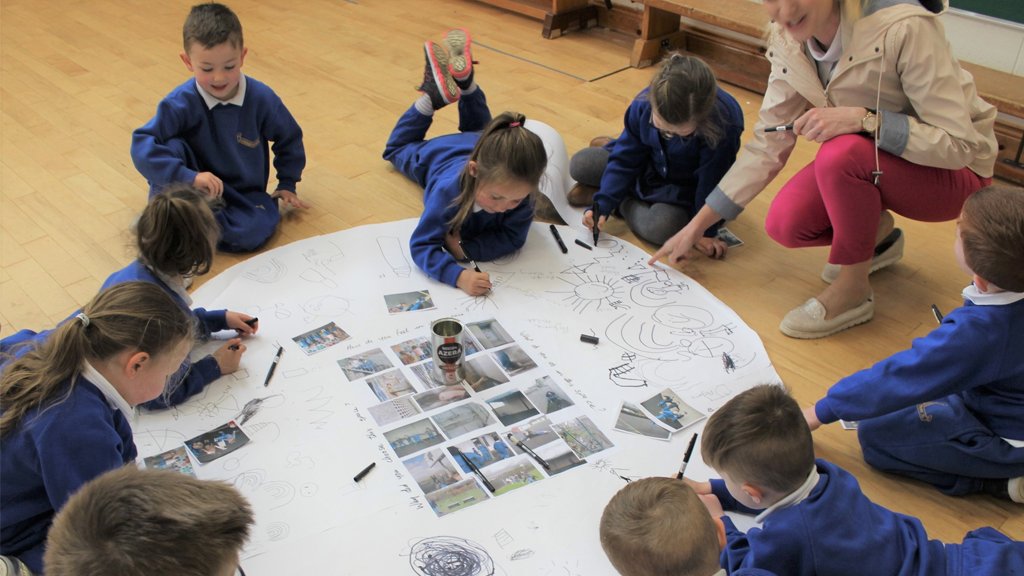
Arts-based learning has emerged as an experiential and interdisciplinary/transdisciplinary approach to STEM education that offers a distinctive new set of tools to advance creativity and engagement among STEM learners (Seifter 2014). The “A” in STEAM (Science, Technology, Engineering, Art, and Mathematics) can represent many art forms, including liberal arts, physical arts, fine arts, design, and music. STEAM education involves a cross-curricular methodology to teaching and learning, creatively linking key concepts across subject areas and generating original ideas through the process of design to solve real-world problems (Buonincontro 2018).
Many now argue that STEAM must become an essential paradigm for creative and artistically infused teaching and learning in the sciences (Henriksen 2014). Herro and Quigley (2016) have recommended that creative activities in schools move beyond the art classroom and across all disciplines. However, educators struggle with a clear conceptualization of STEAM and how the disciplines might be connected (Guyotte et al. 2015; Quigley and Herro 2016). Therefore, preservice and inservice teachers must have high-quality professional development to learn how to effectively incorporate interdisciplinary and transdisciplinary STEAM lessons and activities into their teaching (Hero and Quigley 2016, 2017).
This article describes a STEAM educational and outreach project involving the delivery of STEAM lessons and activities to inservice elementary teachers and their pupils. The lessons were delivered by preservice elementary teachers undertaking a STEAM module during their final semester of a four-year degree program in a College of Education in Ireland. Artistic processes—specifically the process of design and design thinking—were used to reinforce and further develop teachers’ and children’s competencies and skills in STEM by applying their knowledge and understanding of scientific concepts in new, innovative ways. The article will explore the impact of the activities and project on developing attitudes, competencies, and skills toward innovative ways of teaching and learning STEAM education; delivering lessons; and developing best practices in integrated STEAM education.
The STEAM-Ed Project
The STEAM-Ed project was carried out by academics in STEM and Visual Art education at a College of Education in Ireland in collaboration with preservice and inservice elementary teachers and children at all class levels (5–12 years old) in an elementary school in southwest Ireland. The project aimed to inspire and guide effective practices in STEAM education through the delivery of interdisciplinary and transdisciplinary STEAM teaching and learning pedagogies. The STEAM-Ed project specifically focused on integrating visual arts and design while delivering STEAM education.
The STEAM-Ed project was designed and delivered in three phases.
- Phase 1: Developing an Understanding of STEAM Teaching and Learning
- Phase 2: Developing Design-Based STEAM Activities for the Elementary Classroom
- Phase 3: Design Thinking in STEAM Education
The phases are sequential in nature as the learner moves from one stage to the next: understanding and appreciation, inquiring and imagining, and engaging with making and reflecting.
Phase 1: Developing an Understanding of STEAM Teaching and Learning
This phase involved designing and delivering a STEAM education elective module for pre-service primary teachers (N=40). Preservice teachers were immersed in STEM and artistic concepts, skills, and processes, developing their own creative capacities and understanding around STEAM. The module focused on the integration (interdisciplinary and transdisciplinary) of art and design principles, concepts, and techniques with STEM instruction and learning (Marshall 2014; Mcdonald 2010; National Art Education Association 2014).
One cohort of preservice teachers (cohort 1) specialized in STEM education and the other cohort (cohort 2) specialized in Visual Arts education during the four-year degree program. Also, this module was delivered by academics in STEM and Visual Arts education, which involved two different approaches to arts integration:
- Teaching STEM through the arts and exploring STEM concepts through Art and Perception (cohort 1).
- Using visual arts and design to provide a diverse lens on the structure of scientific and artistic work as an integrated approach providing different perspectives, potentially generating diverse and innovative ideas (cohort 2).
Academics from STEM and Visual Arts education worked collaboratively to devise STEAM lab/studio–based workshops for preservice elementary teachers. These workshops provided opportunities to undertake collaborative problem-solving activities, providing preservice teachers with the opportunity to practice pedagogies for promoting creativity, imagination, and generation of critical-thinking skills in the elementary classroom. The problem-solving approach involved a design education–based STEAM approach, connecting the knowledge and skills from STEM and Visual Arts content areas. Design acted as a bridge between STEM and the Visual Arts (Bequette and Bequette 2012) (Table 1). The design-based STEAM activities revolved around three themes: Light, Movement, and Sound.
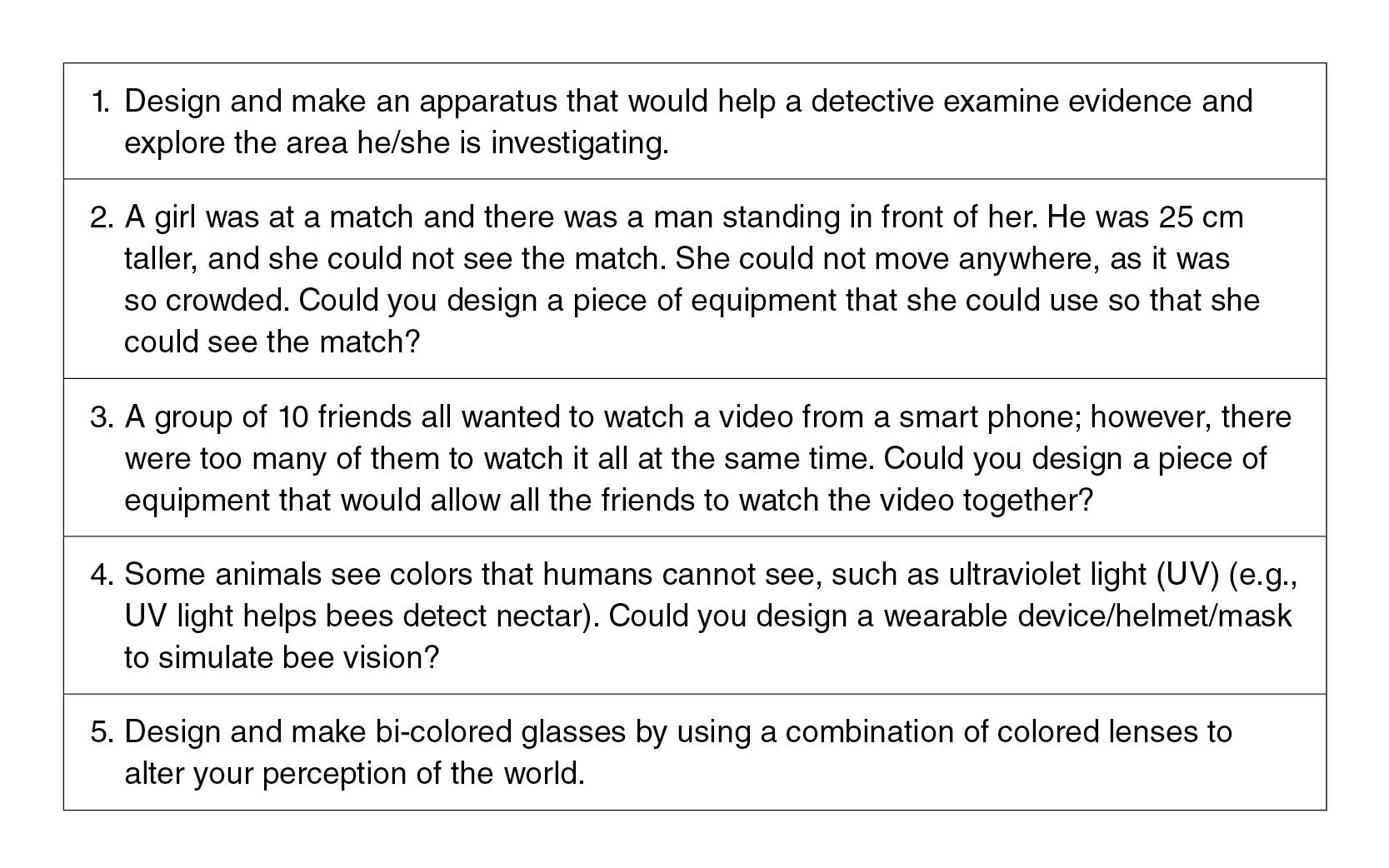
This phase of the project focused on the interdisciplinary and transdisciplinary approach to STEAM teaching and learning pedagogies. Learning concepts and skills from STEM and Visual Arts disciplines that are strongly connected deepen and further develop the preservice teachers’ knowledge, understanding, competencies, and skills. The design activities focused on the STEAM concepts and skills as set out in the Irish Primary school curriculum that are universal and applicable across all education systems (see Table 2 in the Supplementary Resources section).
Phase 2: Developing Design-Based STEAM Activities for the Elementary Classroom
Working in groups of four, preservice teachers planned and practiced innovative design-based STEAM lessons exploring light, movement, and sound. When designing the elementary STEAM lessons, teachers adopted a similar approach that was implemented during their lectures, which were designed using evidence-based best practices (i.e., immersing the children and teachers in STEM and artistic concepts, skills, and processes and using collaborative problem-solving activities to integrate art, design, and STEM principles, concepts, and techniques). The project focused on developing not only the preservice teachers’ creative and design capacities through problem solving design challenges but also the concept of teachers as designers working with tools, content, and ideas to design and craft creative experiences for learners (Mishra and Koehler 2006).
For six weeks, eight groups of preservice teachers delivered STEAM workshops (each two hours long) in the pilot school to teachers and children of all ages and mixed abilities ranging from the infant class (4 years old) to sixth class (12 years old) (N = 205).
The lesson themes included:
- Infants (4–5 years old): Light & Shadows
- Seniors (5–6 years old): Perception of Light Sound and Movement
- First Class (6–7 years old): Color Perception
- Second Class (7–8 years old): Light/Movement/Sound and Space
- Third Class (8–9 years old): Wavelengths of Light and Sound
- Fourth Class (9–10 years old): Movement of Light and Sound Through Materials
- Fifth Class (10–11 years old): Interference in Action
- Sixth Class: (11–12 years old): Transforming Spaces through Light, Movement and Sound
In addition, contemporary artists, designers, and architects delivered two days of workshops to the preservice and inservice teachers and children from infants to sixth class on incorporating new and innovative technologies in exploring scientific concepts through art. The workshops challenged children and teachers to extend their new understanding and skills, and they were used as a vehicle to apply their learning and make further connections in STEAM. Example workshop topics included:
- How sound can be represented visually
- Sound represented as waves through interactive computer program
- Using sensors and data visualization, sensor changing light
- How movement in open spaces can be used to create sound and visuals
- Arduino board to sense temperature/or light in a room
- Color Perception
- Why do we see as we do? Color spectrum, visible and invisible wavelengths of light
Phase 3: Design Thinking in STEAM Education
Design Thinking
The concept of Design Thinking (DT) was introduced into the project to focus on the application of STEAM knowledge and understanding among the preservice and inservice teachers and the children taking part in the STEAM-Ed project. This phase involved a transdisciplinary approach to STEAM education, connecting art and design to STEM (Cross 2011). Transdisciplinary approaches to teaching and learning allow participants to learn through a true blending of disciplines to solve problems (Herro and Quigley 2016; Klein 2014).
In recent times increasing attention has been placed on design and DT and its potential for teaching and learning (Kirschner 2015; Norton and Hathaway 2015). The term “design thinking” refers to thinking skills or practices designers use to create new ideas and solve problems (Cross 2001, 2011). DT is an innovative, creative, and human-centered process that employs collaboration to generate user-focused products, services, or experiences. The DT framework was used in the STEAM-Ed project, as it is a user-friendly model that promotes creative confidence for both the teacher and the learner.
There are several complementary versions of the DT process; the STEAM-Ed project implemented the model proposed by the Hasso-Plattner Institute of Design at Stanford (d.school 2010) (Figure 1). The Stanford pedagogical framework has five sequences of stages: Define, Empathy, Ideation, Prototype, and Test. These stages can be used interchangeably as the design process reciprocates in nature; it may be necessary to go back and forth as ideas change and develop (Plattner, Meinel, and Leifer 2010).
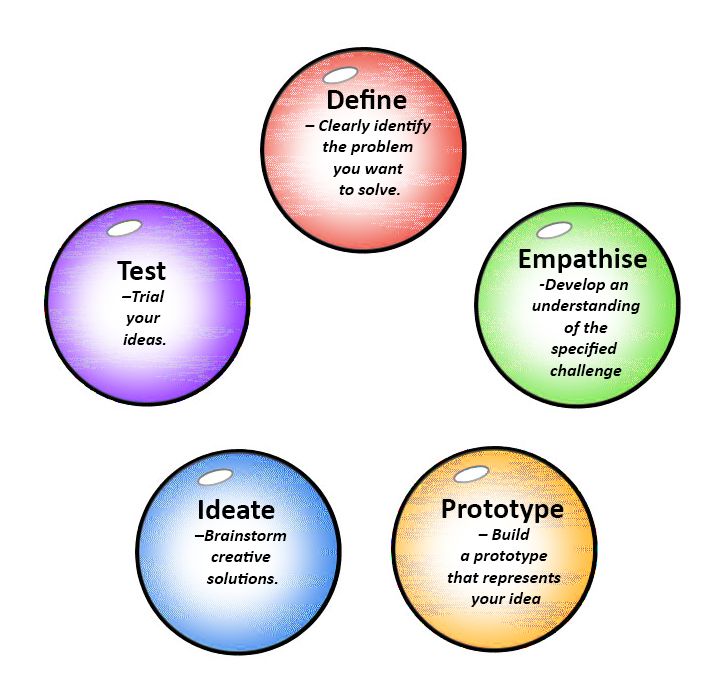
The DT process was employed in the STEAM-Ed project as a methodology and approach to STEAM from the perspective of design education (Bequette and Bequette 2012; Bush, Cox, and Cook 2016; Gross and Gross 2016). Three days of DT workshops were delivered to all teachers and class groups in the school by the STEAM Team (experts in STEAM education and artists and scientists) and preservice teachers. The DT workshops analyzed the information gathered in phases 1 and 2. The STEAM team and children used the information to write a design brief for artists and scientists to design a site-specific art installation. The art installation was to focus on improving or enhancing the quality of teaching and learning spaces within the school, based on the STEAM concepts of light, movement, and sound.
Using Design Thinking in STEAM Education to Create a Design Brief for an Art Installation
The design challenge was developed to situate the learning in the context of the teachers’ and children’s school environment (Putnam and Borko 2000). The DT process encouraged the “Children as Clients” concept where the children worked on a design brief with their teachers. Positioning the children as “clients” gave them a meaningful sense of responsibility and empowerment while promoting their creative potential as they shape the progress of the artists’ and designers’ work. The STEAM team supported and guided the children through the design challenge.
Design Challenge Workshops: Define, Empathy & Ideation
Five DT workshops were delivered (three workshops to all class groups in the school and two with a STEAM committee) (Table 3). A STEAM committee was established to represent every class and child. The committee included three children from each class group (5–12 year olds), the principal, two teachers, a parent, and the researchers (Visual Art and STEM education experts). The function of the STEAM committee was to bring focus to the process; help collate and analyze the data collected; and act as a means of communication between the project leaders, artists, and their peers.
The workshops were divided into the following themes as per the Stanford D School Design Thinking Process (see Table 3):
- DT Workshop 1: Define (With every child and teacher in the school)
- DT Workshop 2: Empathy (With every child and teacher in the school)
- DT Workshop 3: Ideation (With every child and teacher in the school)
- DT Workshop 4: Ideation (With the STEAM committee)
- DT Workshop 5: Presentation of design brief to contemporary artists (The STEAM committee)
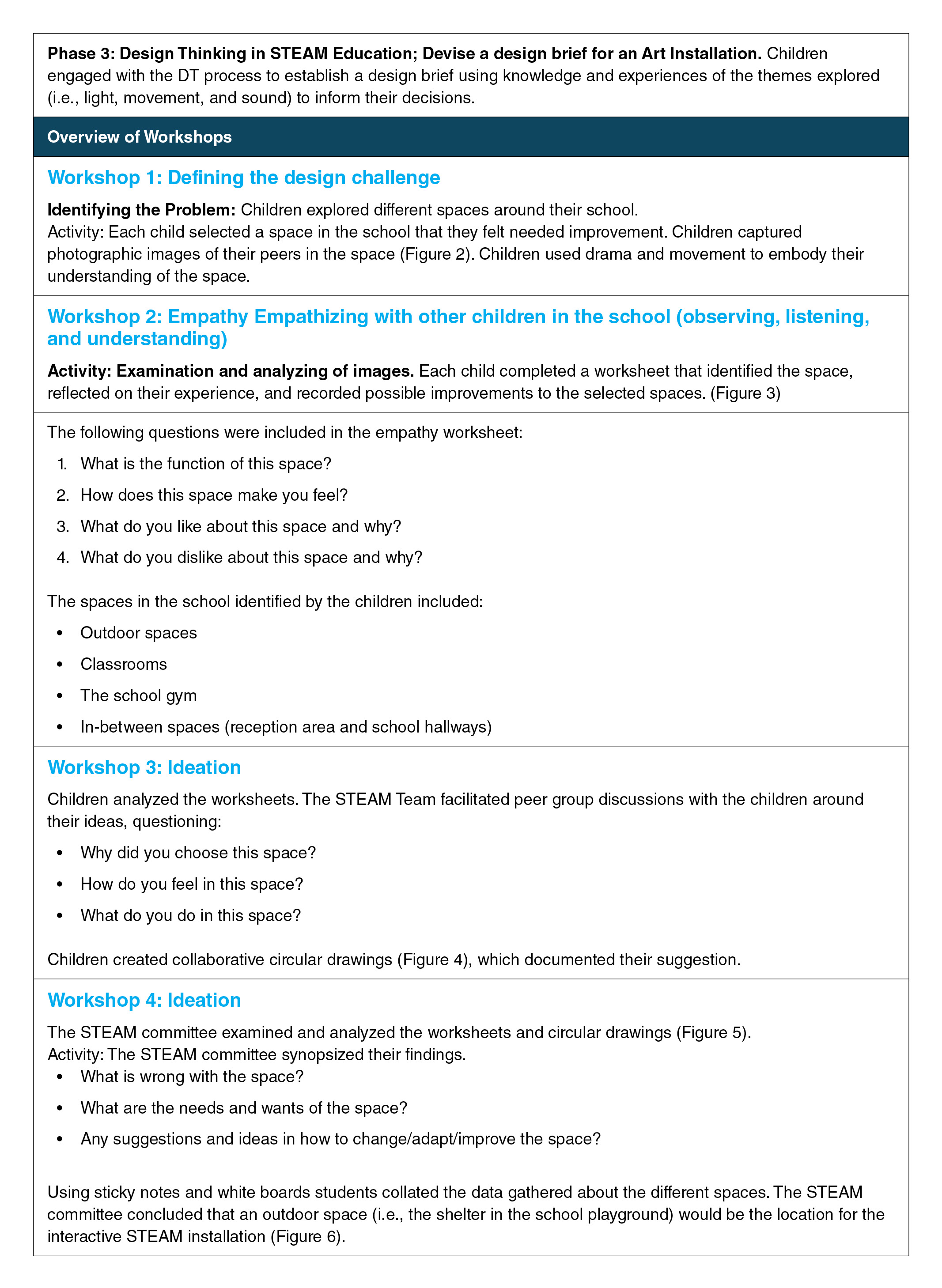
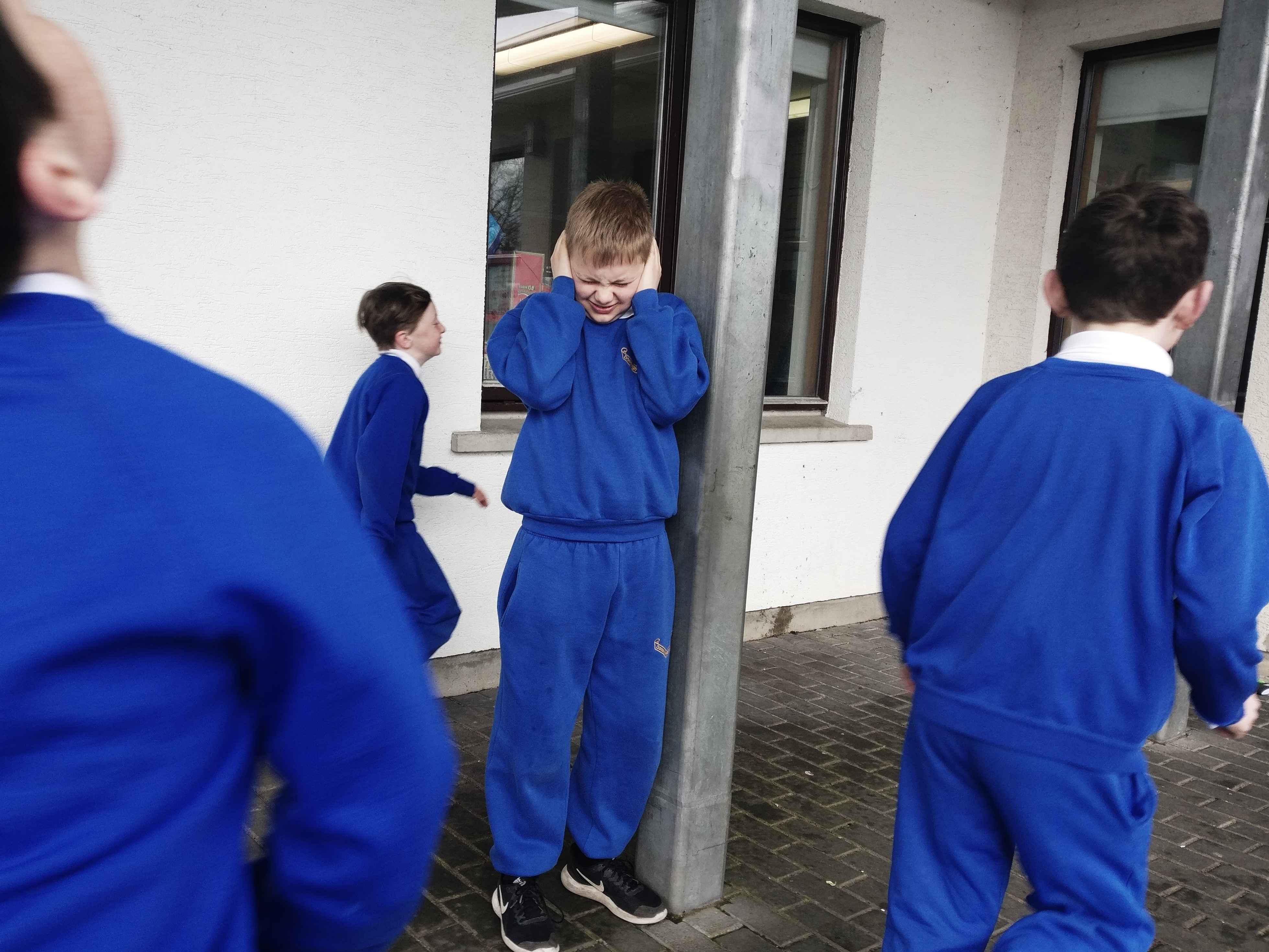
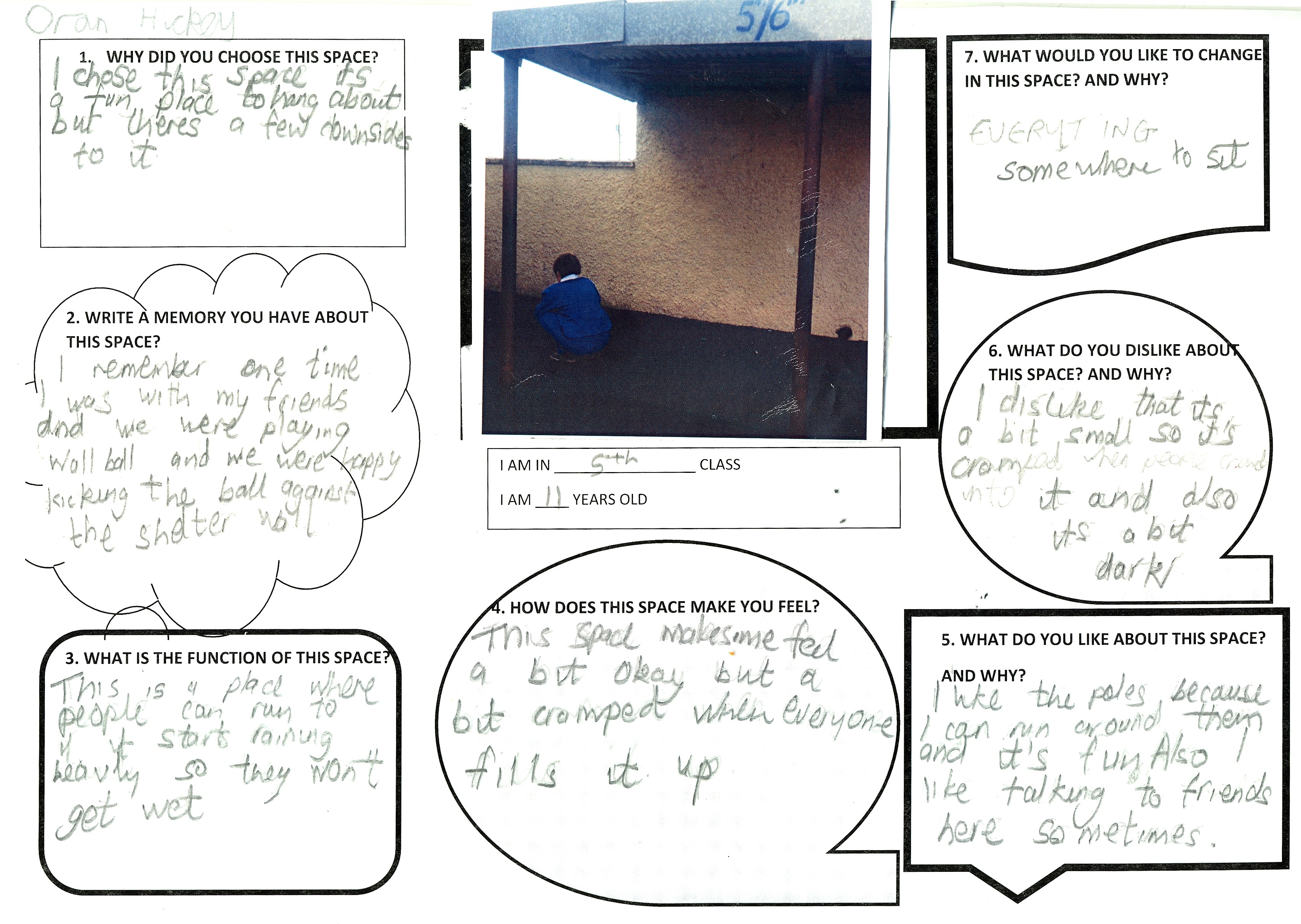
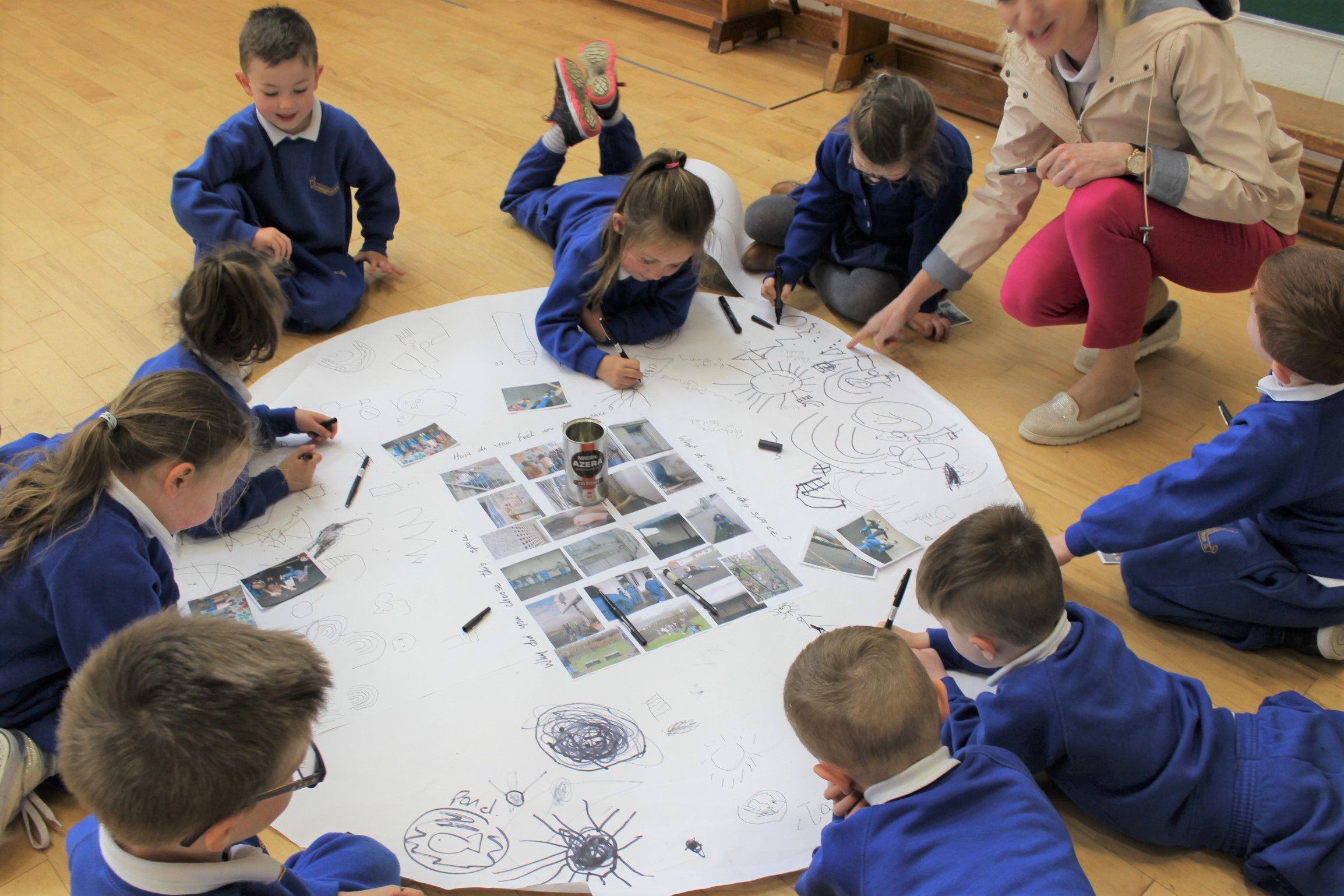
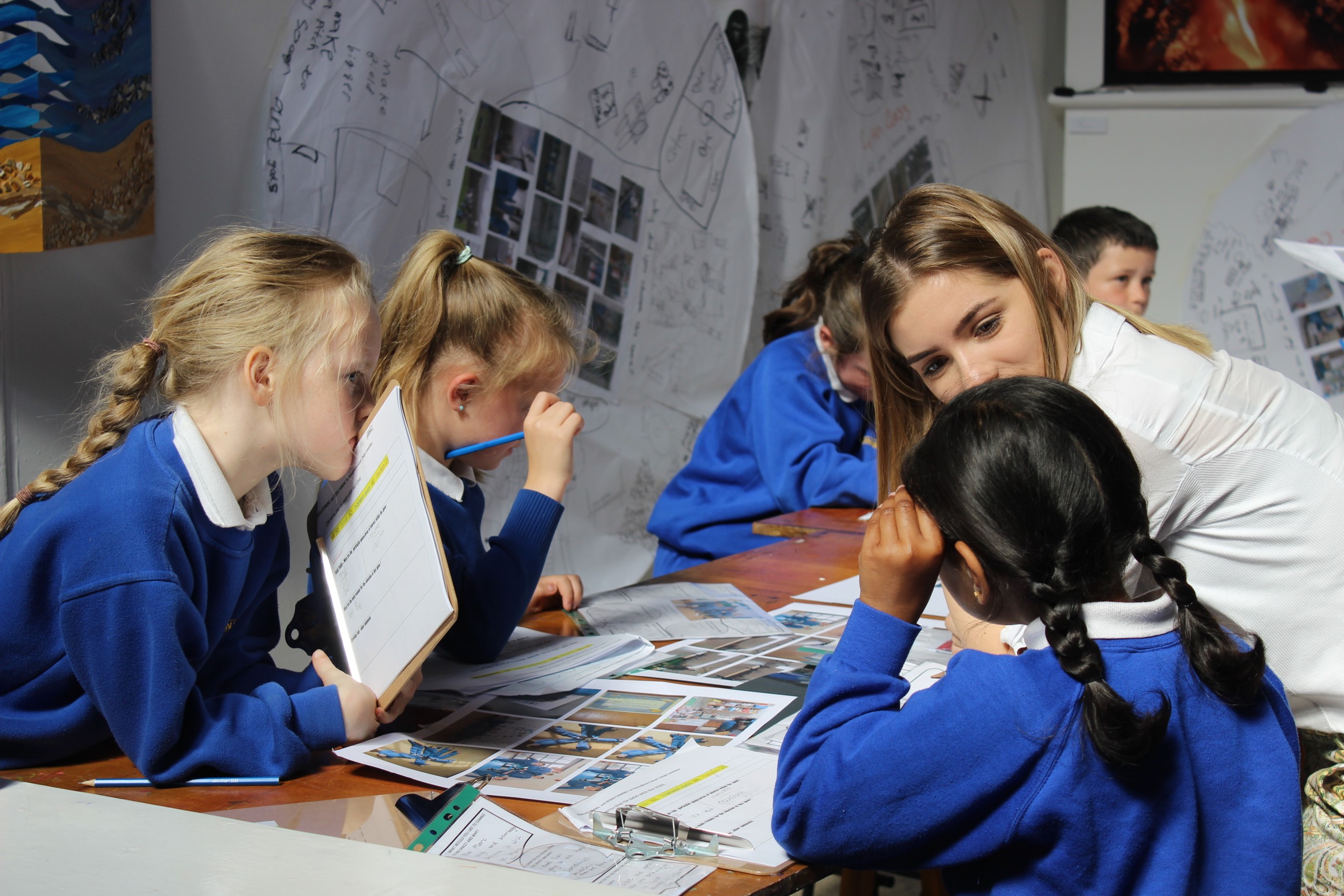
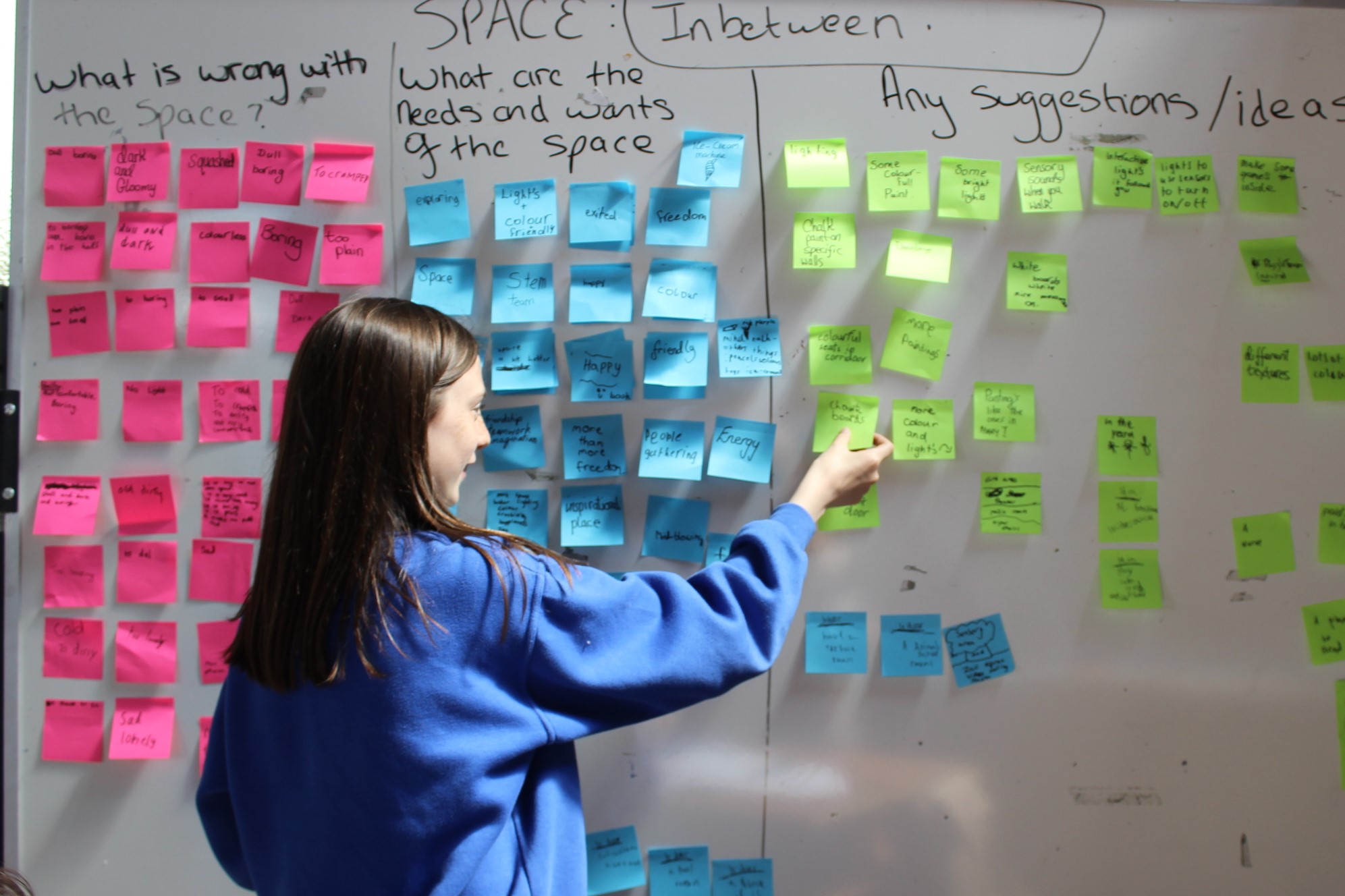
The STEAM committee concluded that an outdoor space (i.e., the shelter in the school playground) would be the location for the interactive STEAM installation based on their analysis of the data collated from every child in the school. The STEAM committee presented their findings to the contemporary artists, designers, architects, and STEAM experts, highlighting the children’s thoughts on what was wrong with this outdoor space (Figure 7), what their needs and wants are in this space, and their ideas and suggestions for improving the outdoor space in their school (see Supplemental Resources for images that reflect needs and wants and ideas and suggestions). The STEAM committee then presented the design brief to the contemporary artists, designers, architects, and STEAM experts (Table 4).
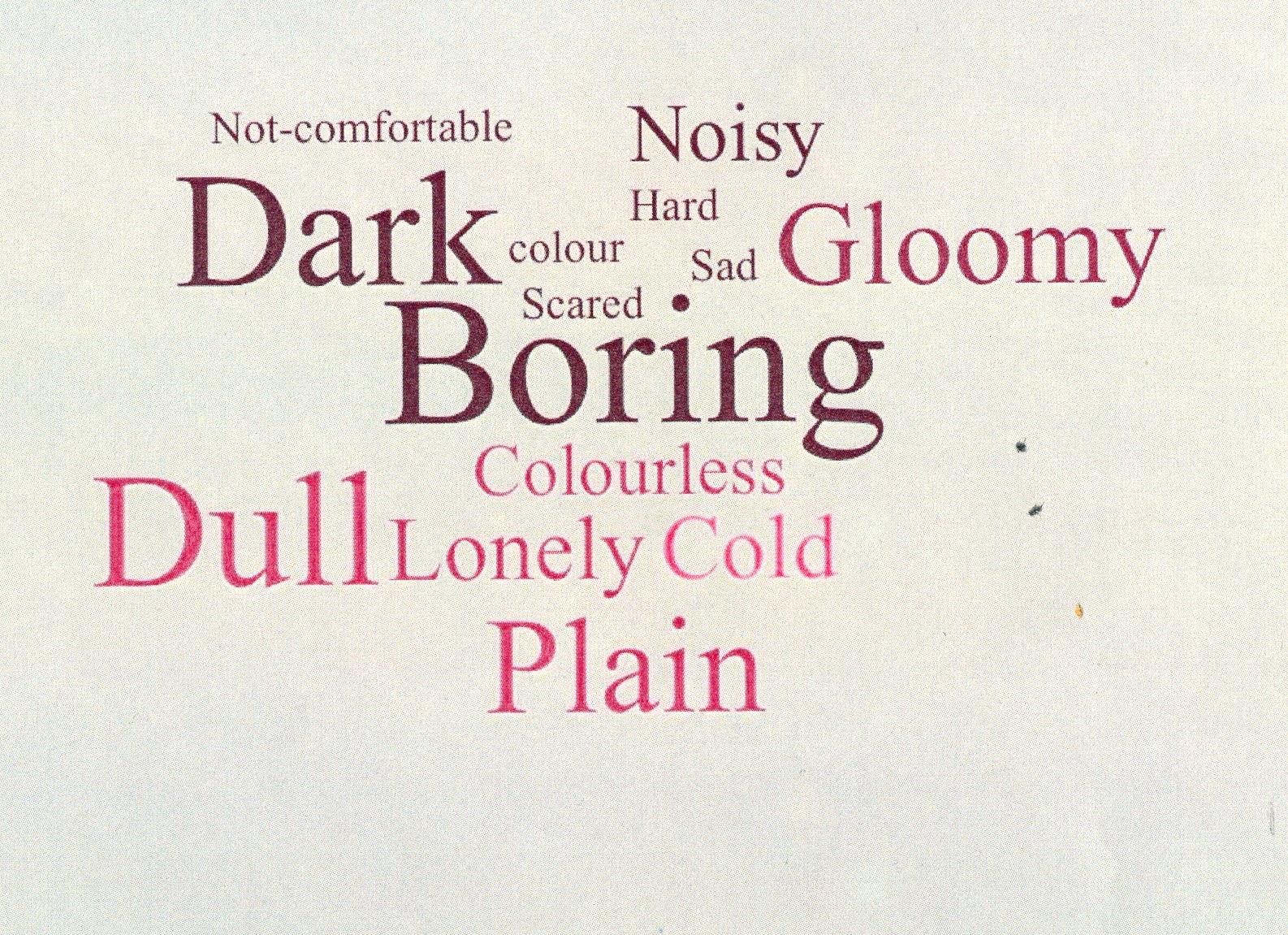
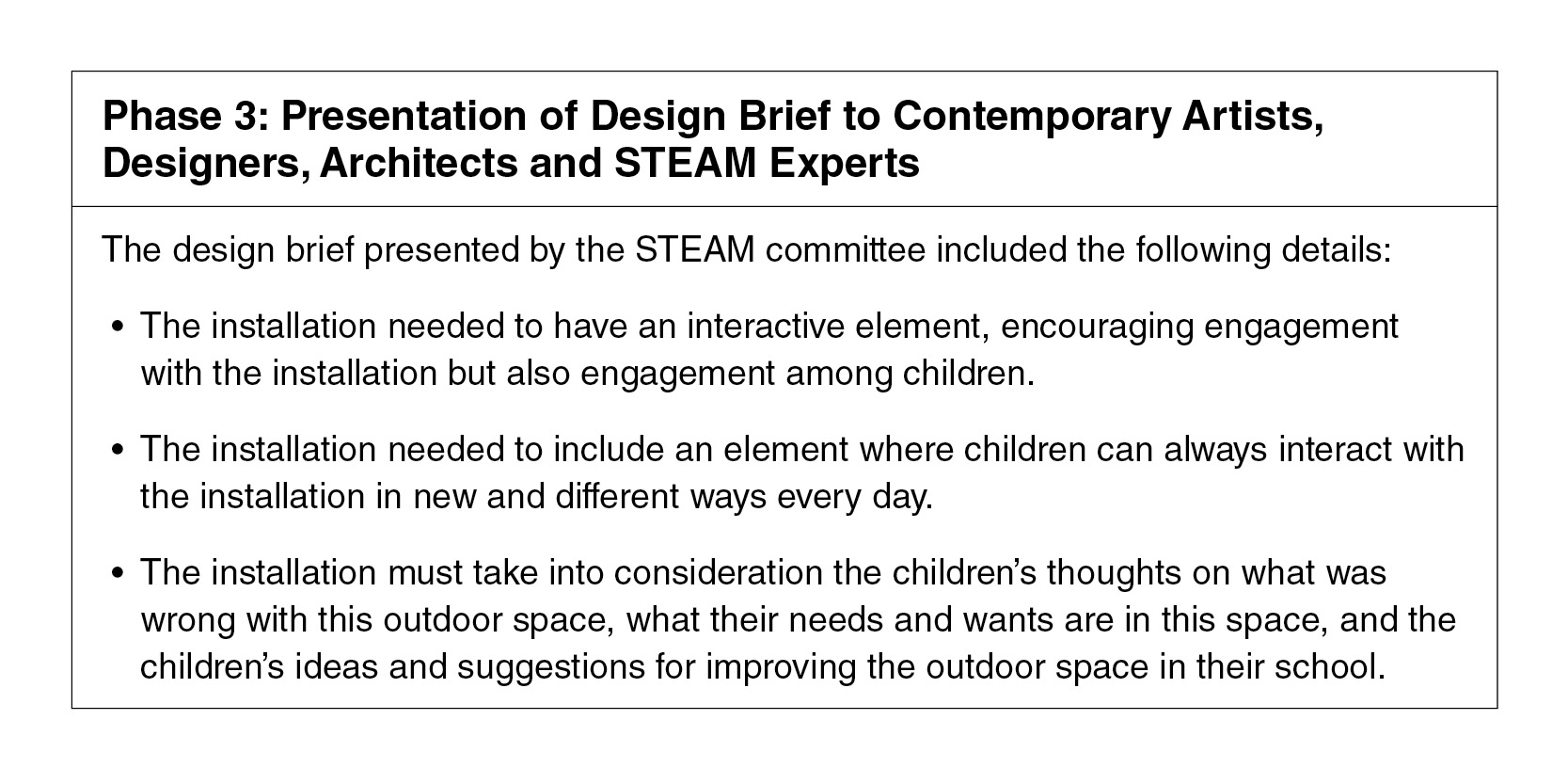
Ideation, Prototyping, and Testing Phase of the Design Thinking Challenge With Contemporary Artists, Designers, Architects, and STEAM Experts
The contemporary artists, designers, architects, and STEAM experts then worked collaboratively with the STEAM committee, management, and teachers in the school on designing and developing an interactive STEAM installation in the children’s school yard. Several iterations of the design were developed; the teachers and children evaluated each iteration, providing feedback for a final design. The final installation combined as many STEAM concepts as possible based on light, movement, and sound.
An interactive social bench was designed with built-in red, green, and blue lights. Copper plates were fitted along the bench (Figure 8). To turn on each light, the children must complete a series circuit using their bodies, making physical connections with the copper plates. They can complete a variety of different circuits (1 bulb, 2 bulbs, or 3 bulbs lighting). The installation promotes interaction among children in a fun, colorful manner in their once “dark,” “gloomy,” “boring,” “lonely,” and “colorless” outdoor space (Figure 7). A variety of different mirrors (convex and concave) were installed on the roof of the shelter, and different-colored light is directed from the back of the bench onto the wall of the shelter. Therefore, the social bench is an educational tool where children can explore energy (light and electricity), light (sources, reflection), color, light, shadows and properties and characteristics of materials.
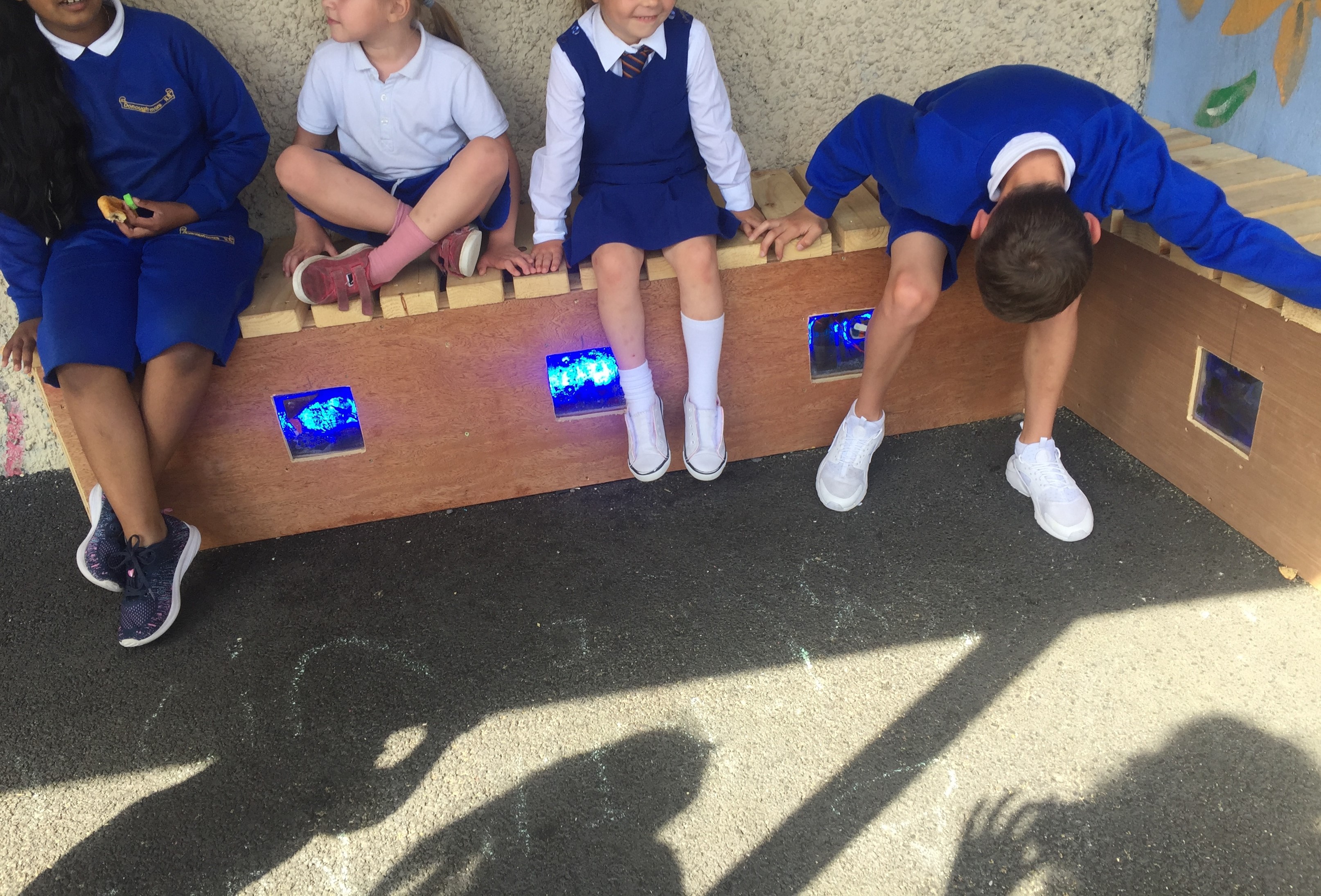
To connect the outdoor space with the indoor space and learning in the classroom, an installation was built in the reception area of the school. Arduino boards were programmed to collect data from a variety of sensors, collecting real-time environmental data from the school playground on the temperature and humidity of the air and the sound levels in the school playground throughout the day (Figure 9). The children can view this data anytime during the day in the display cabinet built at the main reception.
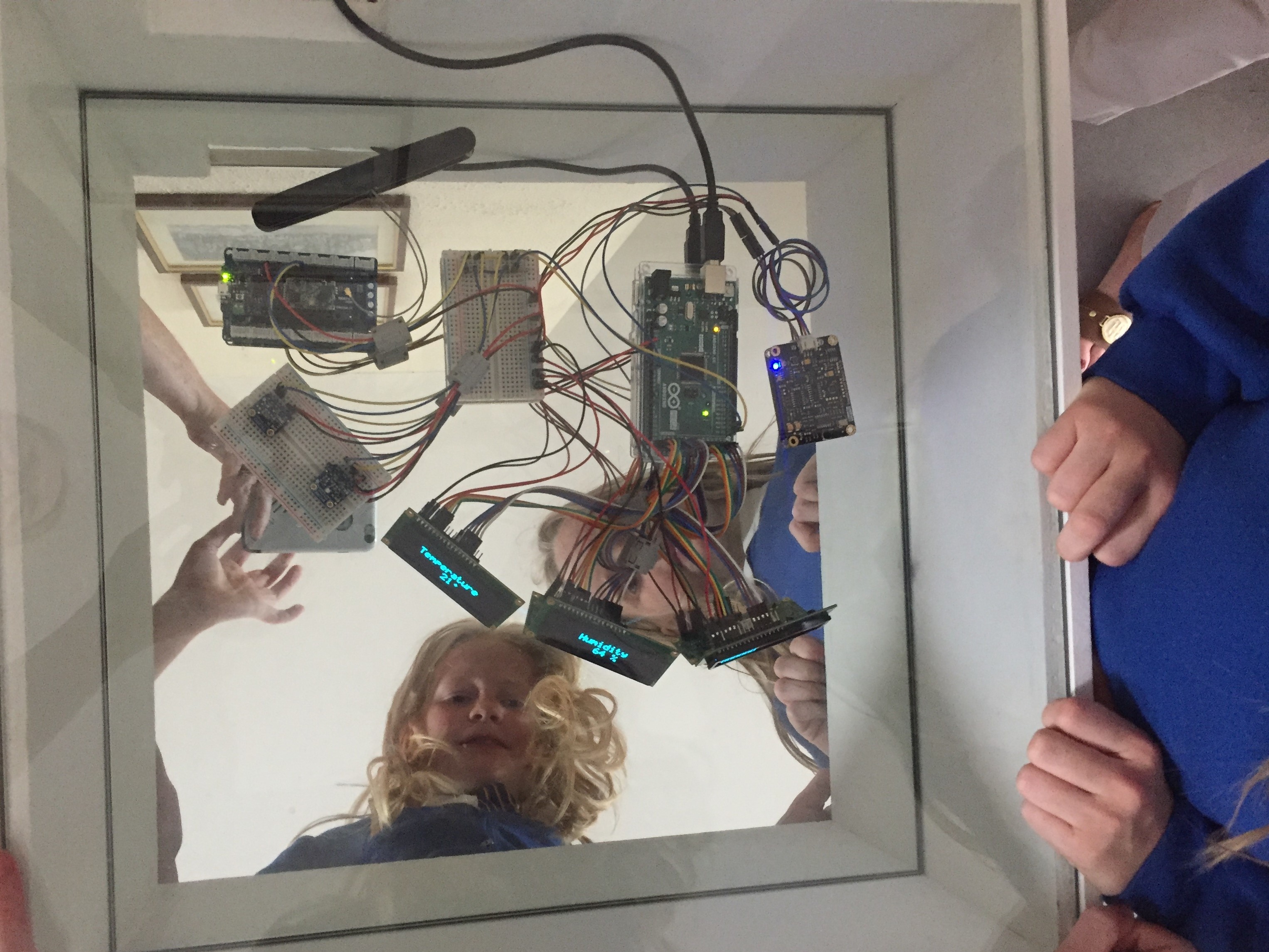
This data was then posted to the school’s IOT analytics ThinkSpeak.com web page (Figure 10). The teachers and children can view this data on a number of wall-mounted electronic tablets displayed in the school and can also access this information in their classrooms. The changing environmental conditions over time can be explored on this web page. The teachers can then incorporate this data into a variety of curricular areas (e.g., science, geography, and mathematics).
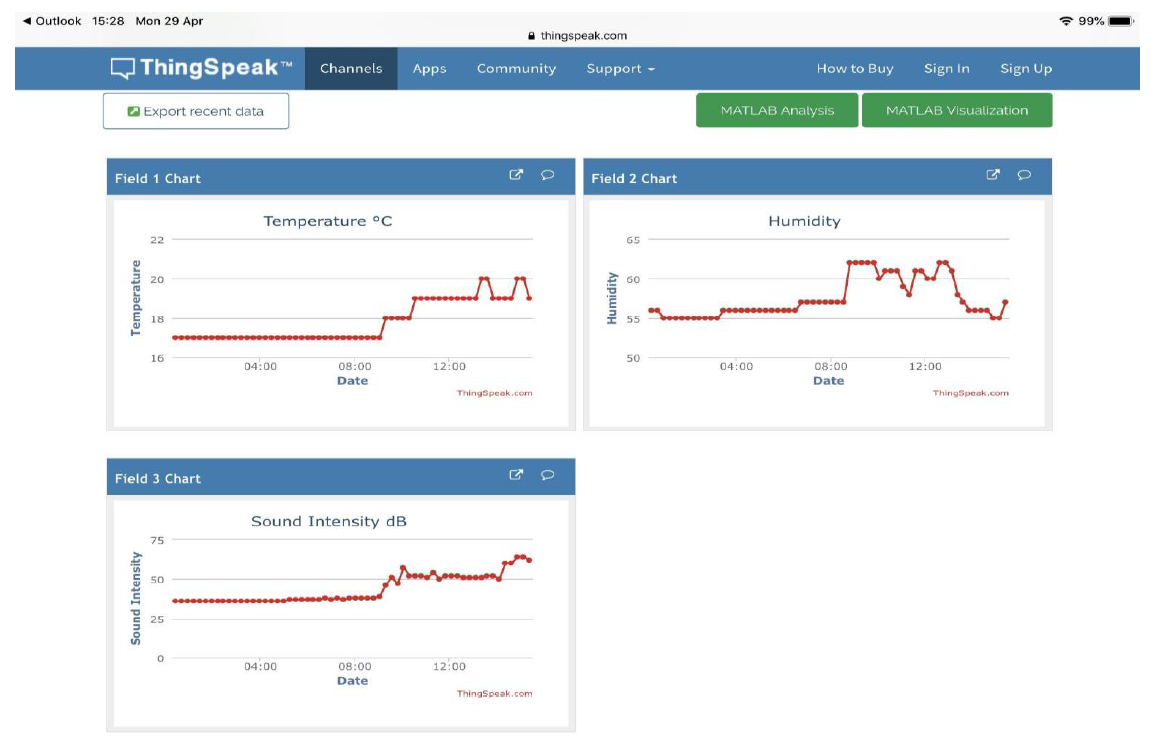
The arduino boards were also connected to a sound source (i.e., programmed to a musical score), where the sound emitted through the speakers in the main reception matched the levels of humidity in the air (e.g., If the air had low humidity levels, the music was had a slower tempo and rhythm and lower pitch. If the air had high humidity levels, the music had a much higher pitch and tempo). This incorporated many concepts around sound (pitch, frequency, loudness, and wavelength), which can be further explored in the classroom.
Research Methodology
To establish a body of knowledge and provide a context for this research, quantitative and qualitative data was gathered from preservice and inservice teachers and children before and after every STEAM and DT workshop throughout the project (focus group data, questionnaires, and preservice teacher’s and children’s reflections and work). Data from preservice teachers’ and children’s work were used to explore their views and experiences of STEAM education. Methodologies included sketchbooks, collaborative drawing, embodiment, listening, observation, photography, and worksheets. Pre-project questionnaires and post-project questionnaires and focus groups were also used to gather data from preservice and inservice teachers.
For the purposes of this article, results of data focused on two outcomes: (1) exploring the impact the project had on developing attitudes, competencies, and skills toward innovative ways of teaching and learning, and (2) how the project explored and developed best practices in the integration of STEAM education into preservice and inservice teaching.
Findings and Discussion
Developing attitudes, competencies, and skills toward innovative ways of teaching and learning STEAM education
Educators struggle with a clear conceptualization of STEAM and how the disciplines might be connected (Quigley and Herro 2016). This was also the case with the preservice teachers prior to partaking in the STEAM-Ed project. Preservice teachers commented on their lack of understanding, “Initially when I heard that it was in fact STEAM and not STEM that we would be teaching I was apprehensive as I could not visualize combining these subject areas together.”
Research has found that many educators incorrectly assume that STEAM involves plugging art into the STEM fields (Piro 2010). Most preservice teachers are aware of STEAM and know what the acronyms stand for; however, they find it difficult to explain the nature of the integration. Teachers lack understanding of how to approach teaching STEAM in a transdisciplinary manner (Herro and Quigley 2017). This was also the case among preservice and inservice teachers in this study.
“My own personal experience of art is limited to primary school. My opinion on its relationship with science was always that the two were completely different entities. Science was limited by what is possible (for now, as it is changing everyday), and art tackles and portrays issues that reflect upon society. It was probably narrow minded but I never saw the two as being linked. However, during this module I noticed that they are both quite conceptual and can certainly be merged.”
Many have reported that there are not enough training programs for teachers, which causes a lack of confidence in STEAM teaching. The STEAM-Ed project was designed to address this issue, focusing on the integration of the visual arts and design in the delivery of STEAM education in initial teacher education. Feedback from preservice teachers highlights that this was achieved.
“During my time in initial teacher education I have completed 5 teaching placements in schools and up until now my understanding of integrated lessons was quite misconstrued. On each placement I was required to create thematic/integration lesson plans. However, my understanding of integration was that subjects are linked quite vaguely in the attempt to deepen understanding of the subject’s content and concepts. This type of integration of subjects is unfocused and does not deepen the children’s understanding of a subject but rather acts as a revision strategy for the children. After having undertaken the STEAM program, I gained a more accurate perception of the term.”
The interdisciplinary approach to STEAM education taken in this project focused on learning and connecting concepts and skills from the STEM and Visual Arts disciplines, which has proven to increase the preservice teachers’ knowledge and understanding in science and thus the teaching of science and STEAM. For example, one such comment from a preservice teacher stated: “The program has improved my confidence in teaching science, which is a subject I was not previously a very confident teacher of … I feel much better equipped to teach science topics and to approach other topics in both STEM and STEAM lessons.”
Best Practices in Integrated Design-Based STEAM Education
The STEAM-Ed project aimed to inspire and guide effective practices in STEAM education through the delivery of interdisciplinary and transdisciplinary STEAM teaching and learning pedagogies. However, as previously alluded to, educators struggle with a clear conceptualization of STEAM and how to effectively teach STEAM education. This project aimed to provide professional development for preservice and inservice teachers in the context of the teaching and learning environment of a school based on practices associated with STEAM education. Feedback from these teachers highlight that design-based STEAM education is a very effective pedagogical tool in Visual Arts and STEM teaching, allowing students to make connections within and across disciplines emphasizing elements of design and creative planning.
Incorporating the arts added an affective component to complex STEM concepts and problems, making it more accessible and more engaging (Peppler 2013; Smith and Pare 2016). Teachers reported the interactive pedagogies engaged and motivated all children. They also noted that children who were reluctant to engage were excited to participate in the interactive STEAM workshops each week and continued to discuss the learning positively several months later. The project had a positive impact on both the teachers and learners, with one preservice teacher sharing, “Possibly one of the most poignant learning experiences from this elective was experiencing the level of engagement and enjoyment of the children.”
The design-based STEAM approach encouraged a high level of engagement from both preservice teachers and children, engaging in problem solving involving creativity and collaboration, drawing on their prior knowledge and learning new concepts from the different STEAM disciplines: “The integrated STEAM program has been immensely influential to me as a future educator. It has provided me with a great insight into the effects and long-term benefits it has on the lives of children and what us as teachers can do to ensure effective learning takes place within the classroom.”
Design Thinking in STEAM Education
The DT workshops were a huge success where children applied the STEAM concepts that they had previously learned during classroom activities to improve the physical teaching and learning environment for all the users within the school. The DT element of the project provided a transdisciplinary approach promoting an original and creative model of education with consideration given to the social, emotional, and cognitive aspects of learning. The participants engaged meaningfully in an authentic STEAM learning experience, which in turn empowered them to use STEAM concepts to make a difference in how they view their immediate world.
It is evident from the children's responses (sketchbooks, collaborative drawing, embodiment, listening, observation, photography) that the project deepened the children's observation and problem-solving skills. The teaching and learning methods used catered to a variety of learning styles and abilities, ensuring every child had an opportunity to access the learning and contribute to the ideas explored. The circular drawings displayed evidence of knowledge transfer as children provided constructive STEAM solutions to improve the social spaces within the pilot school.
One of the most impactful findings was how the process of DT developed empathy and storytelling (Plattner 2010). The empathy stage empowered the children and gave them a sense of ownership over the process of informing the design brief. Children’s lived experiences, stories exchange, and drawings were used to inform the design and prototyping of the resulting art installation by contemporary artists and scientists in the children’s outdoor play space. In addition, the DT process gave space for children to voice concerns and highlight some influential factors in the children’s use of their school environment.
Issues highlighted were mostly based around how the school’s physical environment negatively impacted children's well-being (e.g., children with sensory issues (sound and touch) found areas within the school difficult to navigate and other children struggled with socialization and peer interacting). Many children stated that a busy school playground left them feeling “lonely,” “sad,” and “scared.” The outdoor space was not providing the children with what they phrased as a “place for feeling” where they did not feel vulnerable and “place for being,” which allowed them to “be” themselves as the spaces were very “noisy” (Titman 1994). The children’s experience of the process of DT also elicited positive comments, such as an eight-year-old who said, “I like it, as I got to look at all the ideas that came from my friends and other classes. Looking at all the ideas helped me understand how I feel about my school and how we can all make changes.”
Feedback from the teachers highlighted how the DT model allowed teachers and children to follow a clear process and phases that allowed for scaffolding and the development of creativity and analytic skills (Henricksen 2017; Plattner, Meinel, and Leifer 2010). One example of a comment by a preservice teacher included: “Design thinking provides structure for uncertain teachers to develop more creative and interdisciplinary practices.”
Conclusion
This project highlights the need for any future STEM education strategies to include both STEAM and design thinking methodologies in the classroom. Creative activities in school need to move beyond the art classroom and across all disciplines. STEAM education can be a key game changer in this space where students solve design-based problems (Herro and Quigley 2016). The DT framework proved to be a flexible framework for teachers to use when integrating the arts into STEM education and provided a structure to develop new creative practices to guide their teaching and thinking (Henriksen 2017, 2018).
The STEAM Ed project demonstrates the similarities and links between art, design, and science, breaking down the barriers between individual stand-alone subject areas within the curriculum (Henriksen 2018). Comments from the teachers and children have highlighted that this project impacted their attitudes, competencies and skills toward STEM and the Visual Arts in a positive way. One preservice teacher said, “In my opinion, STEAM is like a toolbox. I have my hammer, my screwdriver, my chisel, but I also have my paintbrush. My paintbrush is my artistic innovative side that, while still in the toolbox with the rest of my tools, is interlinking and ‘rubbing’ off each and everyone one of them.”
Children in older classes (10–12 years old) spoke about the interconnection between the STEAM disciplines, “I did some science and some art but it was mixed up together, it wasn’t either but it was both. The younger children embodied the experience—one child when asked, “Would you like to be an artist/scientist when you grow up?” announced “I am already an artist/scientist.”
Acknowledgments
STEAM Ed Project was funded by Science Foundation Ireland (SFI) Discover Program.
Anne Marie Morrin (AnneMarie.Morrin@mic.ul.ie) is a Visual Art Lecturer at Mary Immaculate College, University of Limerick, Ireland. Maeve Liston (maeve.liston@mic.ul.ie) is director of Enterprise & Community Engagement, Senior Lecturer in Science Education, Mary Immaculate College, Limerick, Ireland.
citation: Morrin, A.M., and M. Liston. 2020. Engaging children with authentic STEAM learning experiences through design-based approaches. Connected Science Learning 2 (4). https://www.nsta.org/connected-science-learning/connected-science-learning-october-december-2020/engaging-children
Interdisciplinary Preservice Science Education STEM Teaching Strategies Informal Education Pre-service Teachers


